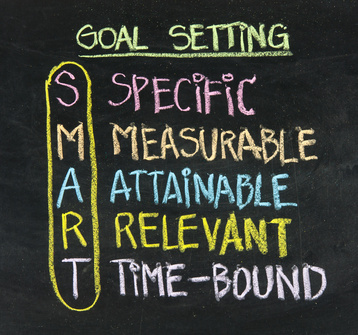
When I was a middle manager, I saw many goals that ended up as roadkill on the business superhighway. Whatever the flavor of the year was, that’s what was reflected in the business goals. Things like: reducing dependence on one client, diversifying our service offerings, and others made the rounds through our business units.
One year our vice president even said something to the effect of “My being here is dependent on reducing our dependence on one particular client.” In hindsight, that goal was accomplished by slowly losing business from that client (because it was clearly not a priority) while not getting new ones. In other words, the overall business is now much smaller, and that vice president is still there.
Goal accomplished, then?
I have the impression that I am not alone in my experience with business goals.
Business goals should be SMART:
- Specific. If your goal is simply “to improve” I’ve got news for you. You probably won’t.
- Measurable. Many wonderful goals are not easily measurable, and their success or failure gets drowned out by the debate.
- Achievable. There’s nothing more demoralizing than being given goals that are outside of someone’s abilities.
- Relevant. Ensuring the coffee is always hot and ready is a fantastic goal (in my office) but not relevant. That’s an extreme example but suffice it to say that it’s easy to set goals for secondary things. Keep them focused on the important performance metrics.
- Time-bound. In my previous company it was standard procedure to set goals that had no end in sight. Unsurprisingly, years later there was a different goal and nobody really knew what the goals meant. You can do everything else right, but you still need to have a time frame to achieve the goal.
Here are some examples of SMART goals you might utilize in your business unit or project:
- Revenue
- Number of clients/customers
- Number of projects
- Revenue per client
- Revenue per project
- Value of repeat business
- Number of repeat customers
- Deadlines achieved (yes/no)
- Number of milestones achieved
- Cost variance
- Schedule variance
- Number of safety incidents
- Amount of lost time
- Safety audit score
- Percent complete at a certain date
- Delivery time
- After sales support response time
- Number of stores/locations
- Number of dealers
- Number of scope changes
- Value of scope changes
- Employee cost
- Employee turnover
- Employee satisfaction
- Utilization rate
- Employee charge out rate
- Number of employees
- Client satisfaction
- Input cost
- Input cost growth/decline rate
- Product selling price
- Number of units produced
- Number of units sold
- Total manufacturing cost
- Price of a supply unit
- Margin
- Manufacturing time
- Amount/value of waste
- Product quality (i.e. six sigma score or similar)
- Number of defects
- Number of warranty returns
- Number of leads generated
- Conversion rate
- Market share
- Market share among certain demographic, geographic area, etc.
- Earnings per share
- Earnings per share growth rate
- Profit
- P/E ratio
- Return on Investment (ROI)
This is simply a list to get your brainstorming started. Good luck making your goals SMART and let me know if you have anything to add!

